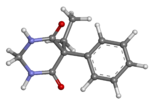 | |
 | |
| Clinical data | |
|---|---|
| Trade names | Lepsiral, Mysoline, Resimatil, others |
| Other names | desoxyphenobarbital, desoxyphenobarbitone |
| AHFS/Drugs.com | Monograph |
| MedlinePlus | a682023 |
| License data | |
| Pregnancy category |
|
| Routes of administration | By mouth |
| Drug class | Anticonvulsant, barbiturate |
| ATC code | |
| Legal status | |
| Legal status | |
| Pharmacokinetic data | |
| Bioavailability | ~100%[4] |
| Protein binding | 25%[4] |
| Metabolism | Liver |
| Elimination half-life | Primidone: 5-18 h, Phenobarbital: 75-120 h,[4] PEMA: 16 h[5] Time to reach steady state: Primidone: 2-3 days, Phenobarbital&PEMA 1-4weeks[6] |
| Excretion | Kidney |
| Identifiers | |
| |
| CAS Number | |
| PubChem CID | |
| DrugBank | |
| ChemSpider | |
| UNII | |
| KEGG | |
| ChEBI | |
| ChEMBL | |
| CompTox Dashboard (EPA) | |
| ECHA InfoCard | 100.004.307 |
| Chemical and physical data | |
| Formula | C12H14N2O2 |
| Molar mass | 218.256 g·mol−1 |
| 3D model (JSmol) | |
| |
| |
| (verify) | |
Primidone, sold under various brand names (including Mysoline), is a barbiturate medication that is used to treat partial and generalized seizures[7] and essential tremors.[8] It is taken by mouth.[7]
Its common side effects include sleepiness, poor coordination, nausea, and loss of appetite.[7] Severe side effects may include suicide and psychosis.[8][7] Use during pregnancy may result in harm to the fetus.[9] Primidone is an anticonvulsant of the barbiturate class;[7] however, its long-term effect in raising the seizure threshold is likely due to its active metabolite, phenobarbital.[10] The drug’s other active metabolite is phenylethylmalonamide (PEMA).
Primidone was approved for medical use in the United States in 1954.[7] It is available as a generic medication.[8] In 2020, it was the 269th most commonly prescribed medication in the United States, with more than 1 million prescriptions.[11][12]
- ^ "Primidone (Mysoline) Use During Pregnancy". Drugs.com. 18 February 2019. Archived from the original on 26 November 2020. Retrieved 16 May 2020.
- ^ Anvisa (31 March 2023). "RDC Nº 784 - Listas de Substâncias Entorpecentes, Psicotrópicas, Precursoras e Outras sob Controle Especial" [Collegiate Board Resolution No. 784 - Lists of Narcotic, Psychotropic, Precursor, and Other Substances under Special Control] (in Brazilian Portuguese). Diário Oficial da União (published 4 April 2023). Archived from the original on 3 August 2023. Retrieved 16 August 2023.
- ^ "Primidone SERB 50mg Tablets - Summary of Product Characteristics (SmPC)". (emc). 18 August 2014. Archived from the original on 5 August 2019. Retrieved 16 May 2020.
- ^ a b c Ochoa JG, Riche W, Passaro EA (2005). Talavera F, Cavazos JE, Benbadis SR (eds.). "Antiepileptic Drugs: An Overview". eMedicine. eMedicine, Inc. Archived from the original on 8 February 2012. Retrieved 2 July 2005.
- ^ CDER, U.S. DEPARTMENT OF HEALTH AND HUMAN SERVICES (2003–2005). "Primidone (Mysoline)". Pharmacology Guide for Brain Injury Treatment. Brain Injury Resource Foundation. Archived from the original on 17 March 2010. Retrieved 2 July 2005.
- ^ Yale Medical School, Department of Laboratory Medicine (1998). "Therapeutic Drug Levels". YNHH Laboratory Manual - Reference Documents. Yale Medical School. Archived from the original on 20 February 2009. Retrieved 13 July 2005.
- ^ a b c d e f "Primidone Monograph for Professionals". Drugs.com. American Society of Health-System Pharmacists. Archived from the original on 29 June 2019. Retrieved 8 April 2019.
- ^ a b c British national formulary: BNF 76 (76 ed.). Pharmaceutical Press. 2018. p. 332. ISBN 9780857113382.
- ^ Cite error: The named reference
birthdefectswas invoked but never defined (see the help page). - ^ Gilman AG, Goodman LS, Rall TW, Murad F, eds. (1985). Goodman and Gilman's The Pharmacological Basis of Therapeutics (7th ed.). New York: Macmillan.
- ^ "The Top 300 of 2020". ClinCalc. Archived from the original on 18 March 2020. Retrieved 7 October 2022.
- ^ "Primidone - Drug Usage Statistics". ClinCalc. Archived from the original on 11 April 2020. Retrieved 7 October 2022.